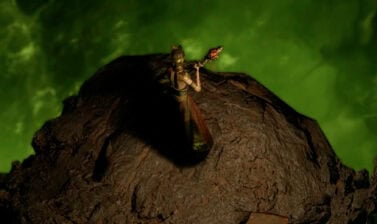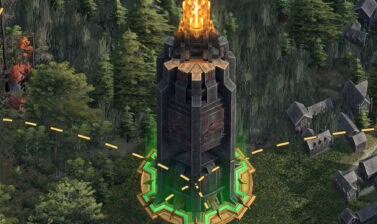Gemcutting in Path of Exile 2 allows us to turn Uncut Skill, Spirit, and Support Gems into their more usable forms. This system has a surprising amount of depth to it, but it is necessary to learn to progress quickly.
Table of contents
What is Gemcutting
Every Gem in Path of Exile 2, be it a drop or Quest Reward, will be provided to us as an Uncut Gem. This not only removes most of the RNG related to drops but also ensures we’re getting what we need when we need it and rarely before.
To equip our skills or even make them stronger, we’ll need to cut these Uncut Gems, which is what the Gemcutting System does for us. This allows us to choose what we want, with the only real restriction being our current Attributes.
To Cut a Gem, we simply need to interact with the Uncut Gem, using it as we would any other consumable. This opens the UI below, where we can choose the exact Gem we’d like to create.

If we’re Cutting a Gem of a higher level, we can also cut a Gem we already have, upgrading it to that level. This is incredibly useful, as not only does it upgrade the gem, but it also transfers over any upgrade we have to its Level, Quality, or Support Sockets.
This system uses many tricks to prevent early, particularly our first, characters from becoming as strong as they can be until much later in the campaign. We’ll get into these systems to break down these walls and help explain Gemcutting as a whole.
Uncut Gem Tiers
One of the major systems that lock off and prevent us from getting too powerful is Gem Tiers. While these are specific to each type of Gem available, they’re a huge factor for limiting our character’s progression, or at the very least, not letting us out-scale content easily.
A Gem’s Tier is determined when it is dropped, and the only way of upgrading the tier is to get a higher tier drop. This overall isn’t too bad, as the harder the content we’re able to clear, the easier it is to get a higher-tier gem.
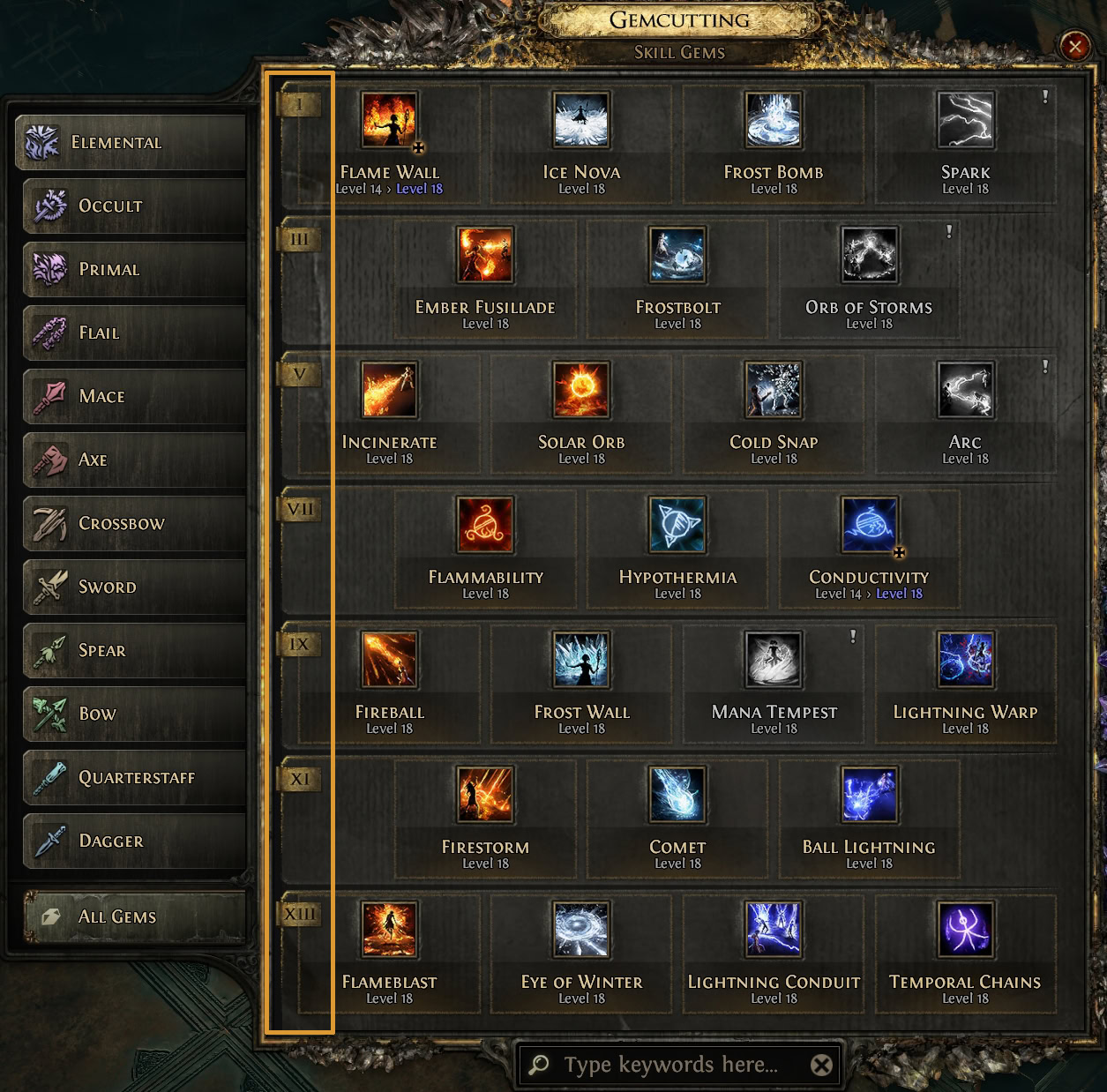
This also means Gems without Level restrictions, like Support Gems, can be passed down to new characters to give them more power very early on. This also works for Skill and Spirit Gems, but the Level Restriction will also hinder our ability to use them
Each type of Gem also has multiple breakpoints for when they become available, or have more options added. Below is a table summarizing these breakpoints and roughly when they would be reached.
| Breakpoint Tiers | Area Level | Progression* |
|---|---|---|
| Tier 1 Skill Gems | 1-3 | Act 1 |
| Tier 1 Support Gems | 1-16 | Act 1 |
| Tier 3 Skill Gems | 7-11 | Act 1 |
| Tier 4 Spirit Gems | 11-15 | Act 1 |
| Tier 5 Skill Gems | 15-19 | Late Act 1 – Act 2 |
| Tier 2 Support Gems | 16-32 | Act 2 |
| Tier 7 Skill Gems | 23-27 | Act 2 |
| Tier 8 Spirit Gems | 27-32 | Act 2 |
| Tier 9 Skill Gems | 32-37 | Act 3 – Act 4 |
| Tier 3 Support Gems | 33-45 | Act 3 – Act 4 |
| Tier 11 Skill Gems | 42- 47 | Act 4 |
| Tier 4 Support Gems | 45-54 | Act 4 – Interludes |
| Tier 13 Skill Gems | 53-59 | Interludes / Endgame |
| Tier 5 Support Gems | 55+ | Interludes / Endgame |
| Tier 14 Spirit Gems | 58-69 | Interludes / Endgame |
As you can see with this table, we’ll have access to the full suite of Skill Gems, Spirit Gems, and Support Gems by the time we reach the endgame activity, Mapping.
Our Skills and Spirit Gems can still go all the way to 20 which extends into the highest tier of Maps available. Though, being fully RNG at this point, these drops have weighting based on the area level that adjusts how often we’ll see them. Below is quick table of the remaining breakpoints
| Tier | Area Level | Minimum Tier* |
|---|---|---|
| Tier 15 | 62 – 73 (Interludes – T9 Maps) | 70 (T6 Maps) |
| Tier 16 | 66 – 76 (T2 – T14 Maps) | 74 (T10 Maps) |
| Tier 17 | 70 – 81 (T6 – T15+ Maps) | 78 (T14 Maps) |
| Tier 18 | 74 – 84 (T10 – T15+ Maps) | 82 (T15+ Maps) |
| Tier 19 | 78 – 84 (T14 – T15+ Maps) | 83 (T15+ Maps) |
| Tier 20 | 82 – 84 (T15+ Maps) | 84 (T15+ Maps) |
Viewing All Gemcutting Options
One thing that may also catch a new player off guard is how limited the selection of gems may appear at a surface level when initially opening a Gemcutting menu. Well, that is due to the game hiding most options and only showing what would be considered the most practical options available.
One way it does this is by creating Gem Categories, which separate Active Skills by Weapon Type, or Buff Skills by the Class most likely to use them. Much like everything else in Path of Exile, these are loose restrictions, as any class can still use any skill.
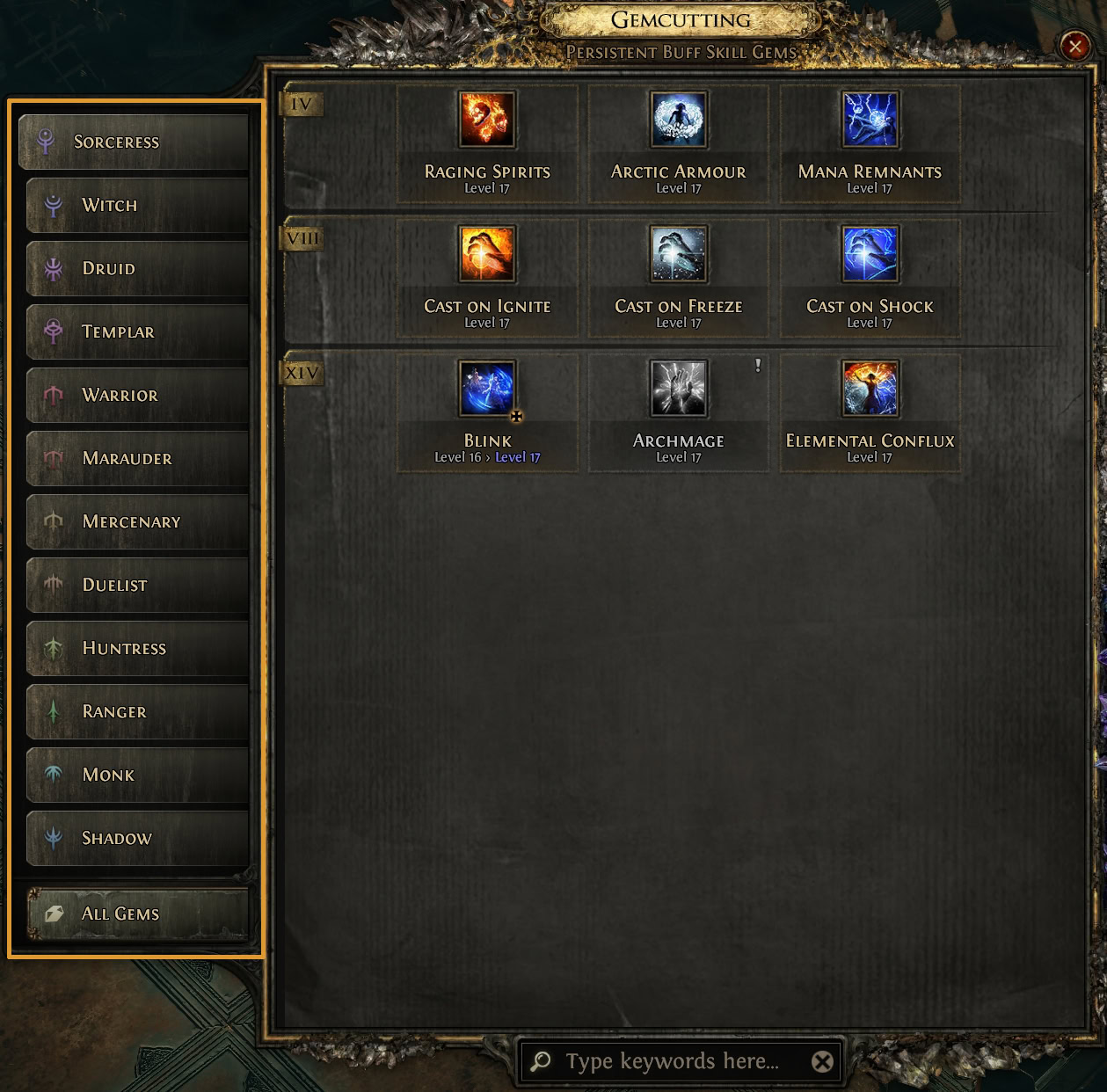
In the highlighted section of the picture above, we can see the Categories for Spirit Gems, and what’s initially shown to a Sorceress. However, at the bottom of that same section, we can set the category to All Gems, which will instead show all of the options. This same thing works for all but Support Gems.
For Support Gems, however, these are always restricted to Support Gems that a skill can make use of in some way.
However, the predetermined selection they show with the initial Gemcutting Menu can be overridden to show all usable support gems.
This can be done by unchecking the option highlighted below labeled “Show Recommended Gems”.
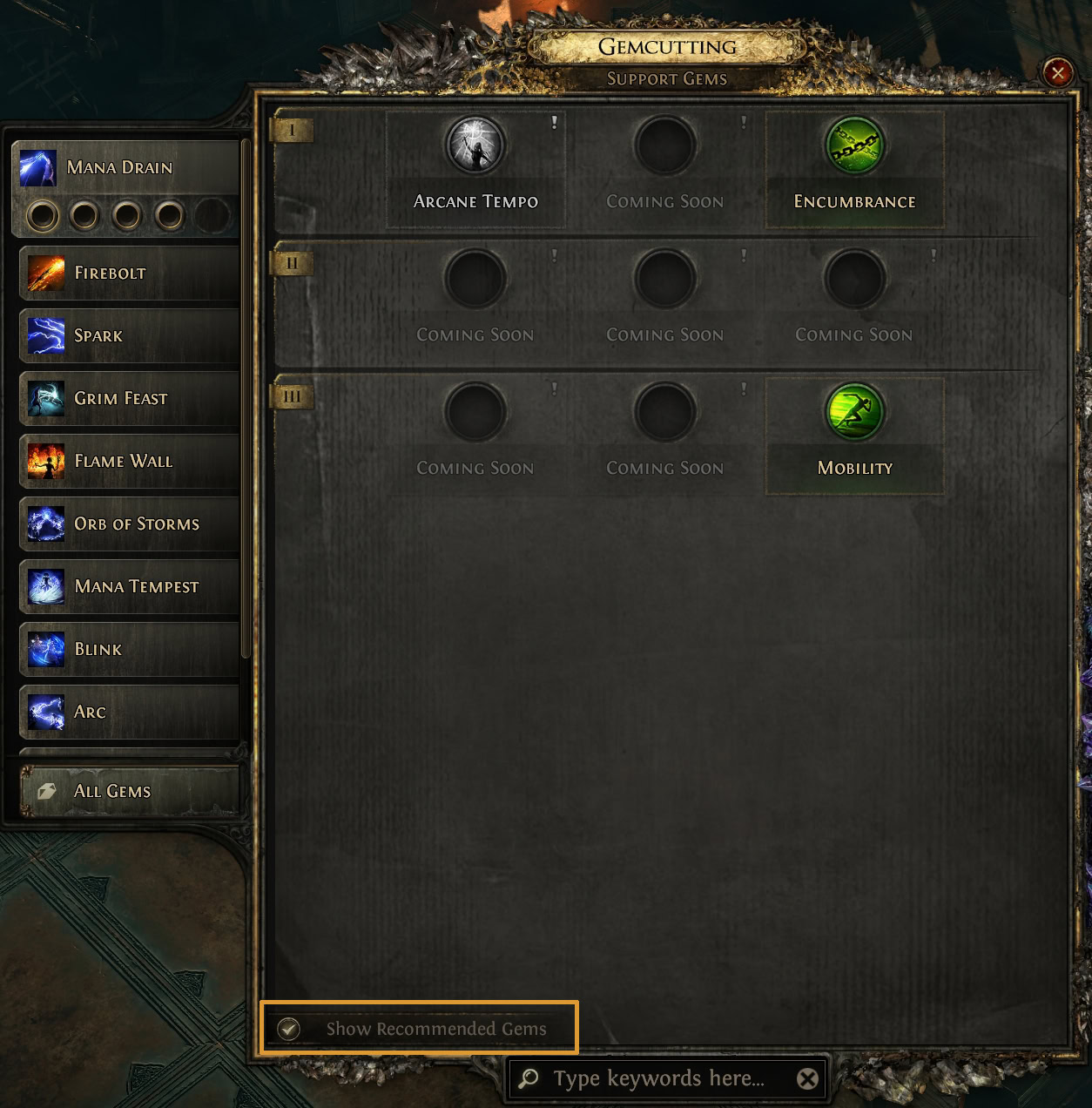
This can be a bit tricky to navigate after, as the game will load up every usable Support Gem. This includes ones that would only be applicable through adding damage or through damage conversion.
This is a great place to make use of the search at the bottom. Searching for keywords like, “Fire”, “Damage”, or “Ailment” will limit what gems are shown to those that are influenced by or interact with those in some way.
Bypassing Gemcutting Restrictions
The other major thing keeping us from over-leveling our gems and simply overwhelming enemies is their Level and Attribute Requirements. While gear can help us mostly ignore any Attribute requirements, Levels are a hard stop to limit our character power or at least the damage output of our Spells.

While there’s not much we can do about these restrictions other than simply leveling or getting the required Attributes, we can still choose to enable an option that will allow us to prepare multiple higher-level gems and ignore the other Gemcutting Restrictions before we reach that point.
To disable this restriction, we’ll open our Settings and head to the Game tab. Here we’ll want to uncheck the “Gemcutting Restrictions” setting as shown below.
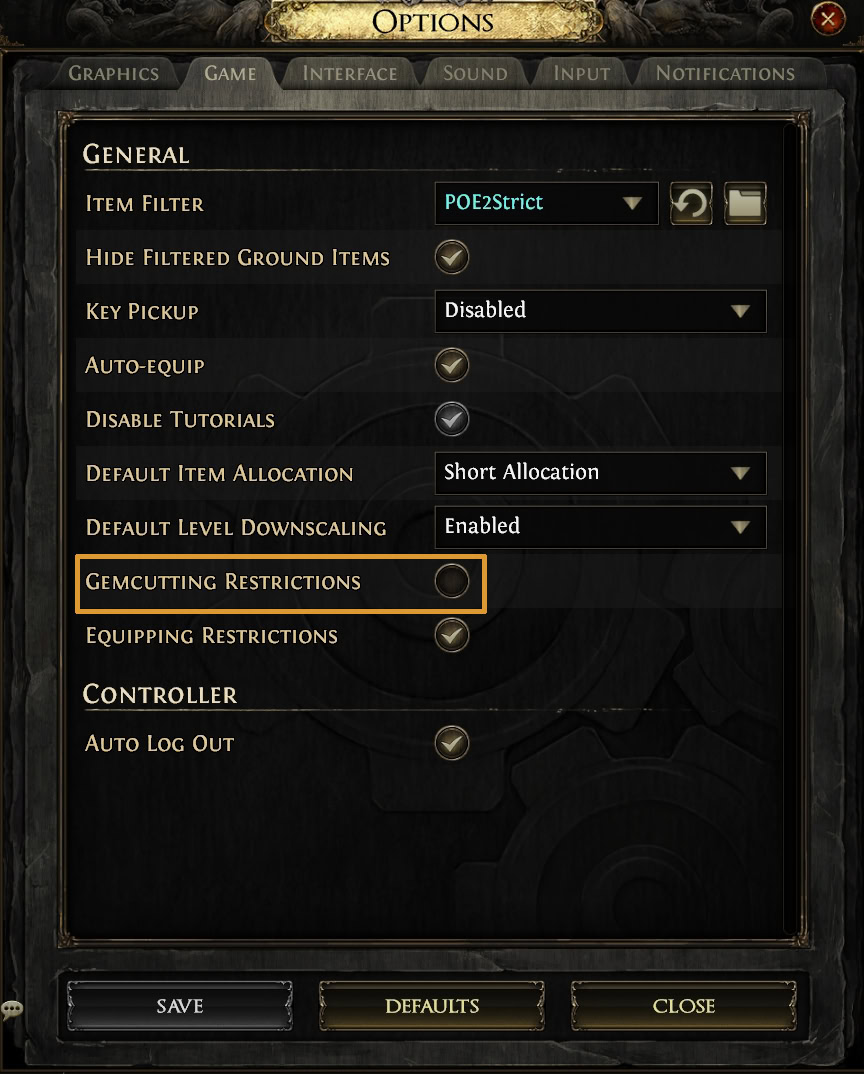
As for what this does for our character, the main thing it does is allow us to cut the same skills we’re currently using without its same upgrades.
Reasons to Disable Gemcutting Restrictions
While we might initially think, “What’s the point of cutting and using a second copy of a gem?” That’s where Corruption and Meta Gems Come in.
Meta gems will require us to cut a second copy of the skill we want to socket, assuming we’re already using it normally. This allows us to manually cast a copy of it, while also having it trigger from our meta gem as well. This also enables us to use different links, as a lot of supports for Spells require us to cast them directly, not have them triggered.
As for Corruption, while inherently a gamble, Vaal Orbs can provide us a way of gaining some early power. It still requires luck, but by making multiple copies of our main skill, we can work around any potential downsides.
Any use of a Vaal Orb has a 25% chance to modify a Gem’s Level, Quality, number of Support Sockets, or do nothing. These effects can decrease or increase those values, but landing additional Support Sockets, in particular, can be quite powerful, potentially giving earlier access to four or five Support sockets.




